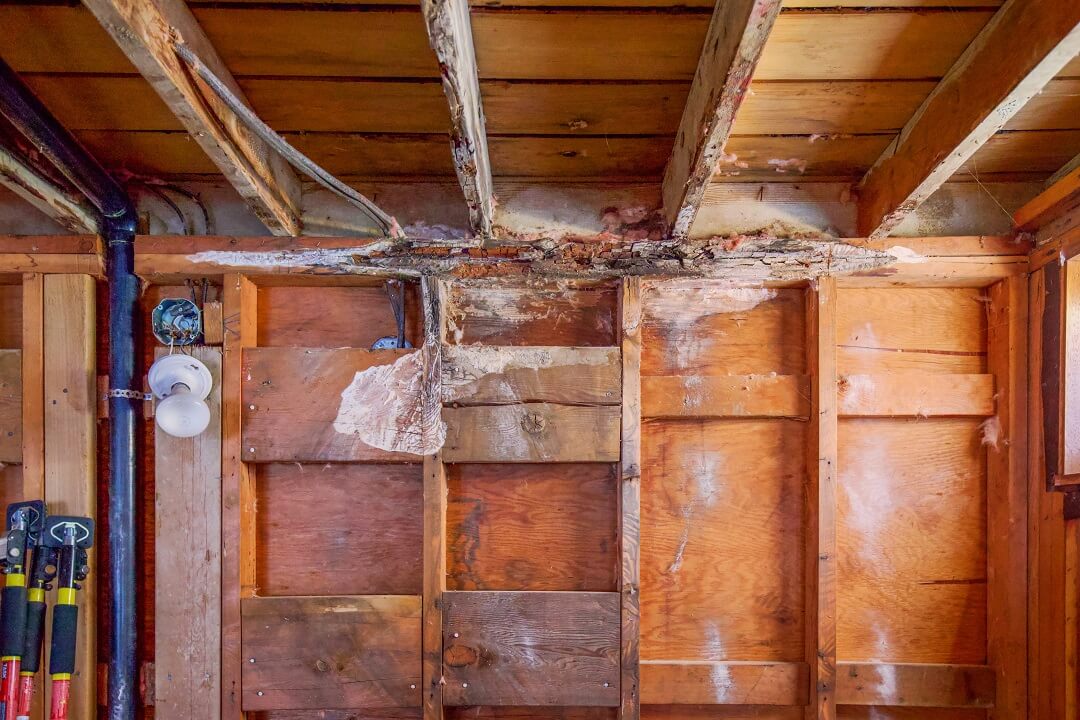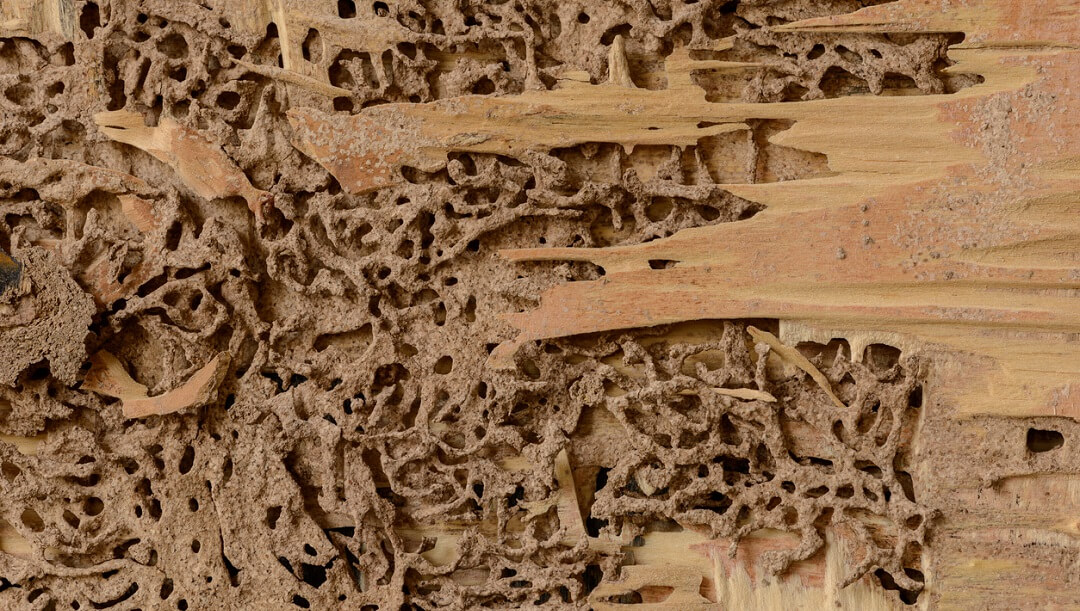As a homeowner, wood rot and termite damage can both be very challenging issues that can put the structural integrity of your home at risk. While both of these can cause significant damage, they each require different treatments, so it is important to understand how to tell the difference between wood rot and the presence of termites.
Discovering cracked or crumbling wood in your home can be concerning. While both wood rot and termite damage can look similar at first glance, there are distinct differences that can help you easily identify the root of your problem.
Here we take a closer look at wood rot, termite infestations, and how to know what is wreaking havoc in your home.
Key takeaways
- Spotting the difference between wood rot and termite damage is key, as they require unique treatment methods. Wrong diagnoses can lead to continuous damage.
- Wood rot, caused by fungi like Serpula lacrymans and Coniophora puteana, weakens wood structure. Signs include color changes, musty odor, and cracks in the wood. To avoid this, check for leaks and manage moisture levels.
- Termites are attracted to decaying wood, chewing through and causing significant damage. Look out for visibly damaged wood, mud tubes, and discarded termite wings. A professional prevention plan with regular termite inspections is recommended.
- Both wood rot and termite damage pose severe risks to your home’s structure. It’s crucial to address any signs of damage promptly to prevent further deterioration.
Wood rot
Wood rot is a form of decay caused by fungi in the wood. Wood rot can compromise the structural integrity of the wood, making it weaker and more prone to collapse. There are two main types of wood rot: dry rot and wet rot.
Causes of wood rot
Wood rot is caused by certain species of fungi that break down the fibers in the wood. With dry rot, the fungi Serpula lacrymans, invades any wood with a moisture content of at least 20%. This form of wood rot can spread quickly and result in extreme structural damage in a short time. The most common cause of wet rot is the fungi Coniophora puteana, which occurs in areas with significant moisture. Wet rot affects untreated wood exposed to water or high moisture levels, such as leaky pipes.
Signs of wood rot
For dry rot:
- Yellow coloration to the wood
- A musty odor
- Cracks along the grain in the wood
- A fine and fluffy white mycelium on the wood surface
- A mushroom-like growth on the wood
For wet rot:
- Darkened appearance of the wood
- A damp and musty smell
- Soft and spongy texture
- The presence of fungal growth
- Shrinkage in the wood
Prevention and treatment
The prevention and treatment of wood rot focuses on eliminating the conditions allowing fungi to thrive in the wood. This begins with a focus on moisture. Checking all pipes for leaks and addressing potential leaks is the first step. If your home has high humidity, you may want to consider a dehumidifier to keep moisture levels down.
After addressing the moisture, you want to focus on the wood itself. Is it treated wood? Treated wood is less susceptible to wood rot. If the wood is untreated, you should consider applying a fungicide to help prevent growth.
If you see signs of wet or dry rot, removing and replacing the infected wood as soon as possible is important to prevent further damage.
Consequences of untreated wood rot
If wood rot goes untreated, the fungal infection will continue to spread throughout all the wood in your home. The wood will deteriorate and collapse, leaving your home unsafe and unstable.
Repairing wood rot
Repairing wood rot typically involves removing and replacing the damaged wood with new wood. Before removing the wood, you will need to determine the full extent of the damage. Then, replace the damaged wood with treated wood. If untreated wood is left behind without damage, you also want to take the time to treat that wood.
Does wood rot attract termites?
Termites are attracted to damp, decaying wood. The fact that wood rot softens the wood makes it an easier target for termites to chew through. In fact, wood rot provides the ideal environment for a termite colony.
Termite damage
Termites feed on wood and other cellulose materials, such as cardboard and paper. When termites invade your home, they feed on wooden structures and can cause significant structural damage.
Causes of termite damage
Termite damage is caused by the termites’ direct destruction of wood. Termites feed on the wood within your home, leaving behind holes or tunnels within the wood and weakening the structural integrity. Some things that can attract termites to the wood in your home include:
- Moisture
- Wooden structures that have direct contact with the soil
- Cracks and gaps that termites can gain access
- Tree branches, firewood piles, or yard debris that makes direct contact with the home
Signs of termites
Signs of termite damage can vary depending on the severity and location of the infestation. Here are some common signs of termite damage:
- Visibly damaged wood
- Cracked of bubbling paint
- Mud tubes
- Discarded termite wings
- Frass, or termite droppings
- Visible termites
- Sagging floors or ceilings
Prevention and treatment
Termite treatment is essential if you have an active termite infestation. This will involve professional termite control specialists that can identify existing colonies and damage while eliminating the pests. Addressing damage immediately is also essential.
Preventing termites begins with identifying any areas of moisture, as termites are more likely to infest a home with increased moisture. In addition, you want to make sure you have no wood in direct contact with the soil. This invites termites directly into your home. With the help of a professional termite control company, you will want to create a termite prevention plan that will include the application of physical barriers, chemical treatments, and regular termite inspections.
Repairing termite damage
Termite damage repair begins with eliminating the termites, identifying all the damaged wood, and removing it. Once removed, you want to replace the wood with treated wood designed to help prevent a re-infestation.
Consequences of untreated termite infestation
If termite damage goes untreated, it can lead to significant structural damage to a building. Termites can feed on wood and other cellulose-based materials, causing walls, ceilings, floors, and other parts of the structure to weaken and become unstable. This can lead to dangerous situations, such as collapses, which can cause serious injury.
Comparison table
| Wood Rot | Termite Damage | |
|---|---|---|
| Appearance | Shrunken in size, darker color, cracks along the wood grain, presence of mushroom-like structures | Tunnels in the wood, the appearance of termites |
| Location | Often found near sources of moisture, such as near leaky pipes | You may notice swollen floors or ceilings, as well as paint bubbles on the walls |
| Texture | Spongy, wet, brittle, a skin covering | Wood may feel hollow, have tunnels or holes within the wood |
| Damage Severity | Often limited to moist wood, but fungi can spread to other areas | Depends on the size of the infestation but large colonies can cause significant damage |
Which is worse: wood rot or termite damage?
Both wood rot and termites can cause significant damage to a building, so determining which is worse can be difficult. In some cases, wood rot can be easier to detect and repair than termite damage. However, both wood rot and termite damage can lead to serious structural problems if left untreated. It’s important to address any signs of damage as soon as possible to prevent further deterioration and ensure the safety and stability of the building.
Understanding the damage to your home and what it means
Learning how to identify wood rot and termite damage is essential in order to ensure you are treating the correct issue. While both wood rot and termites can cause significant damage to your home, treatment and repair options are different for both. When it comes to wood rot, ensuring you have no leaks and are keeping moisture levels down should help reduce the risk. In terms of termites, regular termite inspections and a professional preventative plan in place can help ensure that your home stays termite-free.
Addressing termite damage immediately
At Insight Pest Management, our termite experts understand how much damage a termite infestation can cause. While we are experts at eliminating these destructive pests, we also specialize in creating prevention plans that help ensure your home is safe from the damage termites can cause.
To learn more about termite prevention, schedule a free evaluation today.




